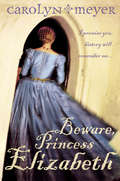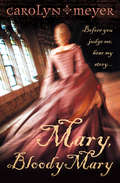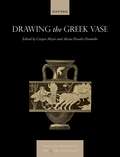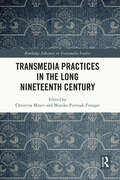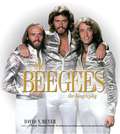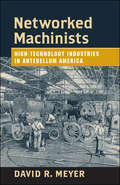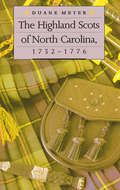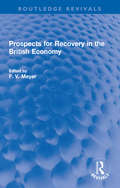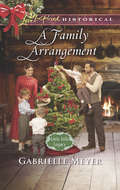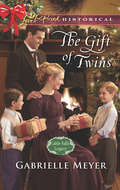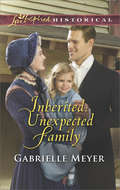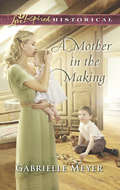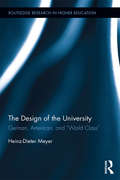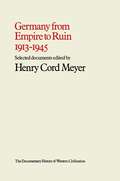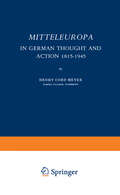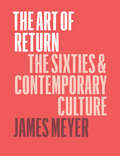- Table View
- List View
Beware, Princess Elizabeth: A Young Royals Book (Young Royals Ser. #Bk. 2)
by Carolyn MeyerA matter of life and death – and the Throne of England
Mary, Bloody Mary (Young Royals Ser. #1)
by Carolyn MeyerBlood is thicker than water – unless the King decrees otherwise.
Drawing the Greek Vase (Visual Conversations in Art and Archaeology Series)
by Caspar Meyer Alexia Petsalis-DiomidisHow have two-dimensional images of ancient Greek vases shaped modern perceptions of these artefacts and of the classical past? This is the first scholarly volume devoted to the exploration of drawings, prints, and photographs of Greek vases in modernity. Case studies of the seventeenth to the twentieth century foreground ways that artists have depicted Greek vases in a range of styles and contexts within and beyond academia. Questions addressed include: how do these images translate three-dimensional ancient utilitarian objects with iconography central to the tradition of Western painting and decorative arts into two-dimensional graphic images carrying aesthetic and epistemic value? How does the embodied practice of drawing enable people to engage with Greek vases differently from museum viewers, and what insights does it offer on ancient producers and users? And how did the invention of photography impact the tradition of drawing Greek vases? The volume addresses art historians of the seventeenth to twentieth centuries, archaeologists and classical reception scholars.
Transmedia Practices in the Long Nineteenth Century (Routledge Advances in Transmedia Studies)
by Christina Meyer Monika Pietrzak-FrangerThis volume provides engaging accounts with transmedia practices in the long nineteenth century and offers model analyses of Victorian media (e.g., theater, advertising, books, games, newspapers) alongside the technological, economic, and cultural conditions under which they emerged in the Anglophone world. By exploring engagement tactics and forms of audience participation, the book affords insight into the role that social agents – e.g., individual authors, publishing houses, theatre show producers, lithograph companies, toy manufacturers, newspaper syndicates, or advertisers – played in the production, distribution, and consumption of Victorian media. It considers such examples as Sherlock Holmes, Kewpie Dolls, media forms and practices such as cut-outs, popular lectures, telephone conversations or early theater broadcasting, and such authors as Nellie Bly, Mark Twain, and Walter Besant, offering insight into the variety of transmedia practices present in the long nineteenth century. The book brings together methods and theories from comics studies, communication and media studies, English and American studies, narratology and more, and proposes fresh ways to think about transmediality. Though the target audiences are students, teachers, and scholars in the humanities, the book will also resonate with non-academic readers interested in how media contents are produced, disseminated, and consumed, and with what implications.
Transmedia Practices in the Long Nineteenth Century (Routledge Advances in Transmedia Studies)
by Christina Meyer Monika Pietrzak-FrangerThis volume provides engaging accounts with transmedia practices in the long nineteenth century and offers model analyses of Victorian media (e.g., theater, advertising, books, games, newspapers) alongside the technological, economic, and cultural conditions under which they emerged in the Anglophone world. By exploring engagement tactics and forms of audience participation, the book affords insight into the role that social agents – e.g., individual authors, publishing houses, theatre show producers, lithograph companies, toy manufacturers, newspaper syndicates, or advertisers – played in the production, distribution, and consumption of Victorian media. It considers such examples as Sherlock Holmes, Kewpie Dolls, media forms and practices such as cut-outs, popular lectures, telephone conversations or early theater broadcasting, and such authors as Nellie Bly, Mark Twain, and Walter Besant, offering insight into the variety of transmedia practices present in the long nineteenth century. The book brings together methods and theories from comics studies, communication and media studies, English and American studies, narratology and more, and proposes fresh ways to think about transmediality. Though the target audiences are students, teachers, and scholars in the humanities, the book will also resonate with non-academic readers interested in how media contents are produced, disseminated, and consumed, and with what implications.
The Bee Gees: The Biography
by David N. MeyerThe first narrative biography of the Bee Gees, the phenomenally popular vocal group that has sold more than 200 million records worldwide—sales in the company of the Beatles and Michael Jackson. The Bee Gees is the epic family saga of brothers Barry, Robin, and Maurice Gibb, and it's riddled with astonishing highs—especially as they became the definitive band of the disco era, fueled by Saturday Night Fever and crashing lows, including the tragic drug-fueled downfall of youngest brother, Andy. In recent years, a whole new generation of fans has rediscovered the undeniable grooves and harmonies that made the Bee Gees and songs like Stayin' Alive, How Deep is Your Love, To Love Somebody, and I Started a Joke timeless.
Networked Machinists: High-Technology Industries in Antebellum America (Johns Hopkins Studies in the History of Technology)
by David R. MeyerA century and a half before the modern information technology revolution, machinists in the eastern United States created the nation's first high technology industries. In iron foundries and steam-engine works, locomotive works, machine and tool shops, textile-machinery firms, and firearms manufacturers, these resourceful workers pioneered the practice of dispersing technological expertise through communities of practice. In the first book to study this phenomenon since the 1916 classic, English and American Tool Builders, David R. Meyer examines the development of skilled-labor exchange systems, showing how individual metalworking sectors grew and moved outward. He argues that the networked behavior of machinists within and across industries helps explain the rapid transformation of metalworking industries during the antebellum period, building a foundation for the sophisticated, mass production/consumer industries that figured so prominently in the later U.S. economy.
The Highland Scots of North Carolina, 1732-1776
by Duane MeyerMeyer addresses himself principally to two questions. Why did many thousands of Scottish Highlanders emigrate to America in the eighteenth century, and why did the majority of them rally to the defense of the Crown. . . . Offers the most complete and intelligent analysis of them that has so far appeared.--William and Mary QuarterlyUsing a variety of original sources -- official papers, travel documents, diaries, and newspapers -- Duane Meyer presents an impressively complete reconstruction of the settlement of the Highlanders in North Carolina. He examines their motives for migration, their life in America, and their curious political allegiance to George III.
Prospects for Recovery in the British Economy (Routledge Revivals)
by F. V. MeyerFirst published in 1985, Prospects for Recovery in the British Economy examines the origins of the economic downturn of the early 1980s. The book explores the causes of the decrease in industrial production and employment during the early 1980s and considers the longer-term cyclical problems of the British economy. In doing so, it provides a detailed study on downturn and recovery from a variety of perspectives. Topics covered include the role of the financial markets; the decline in profitability and productivity in the manufacturing industry; and, the social implications of long-term trends. Prospects for Recovery in the British Economy is ideal for those with an interest in the history of the British economy and the history of economic thought.
Prospects for Recovery in the British Economy (Routledge Revivals)
by F. V. MeyerFirst published in 1985, Prospects for Recovery in the British Economy examines the origins of the economic downturn of the early 1980s. The book explores the causes of the decrease in industrial production and employment during the early 1980s and considers the longer-term cyclical problems of the British economy. In doing so, it provides a detailed study on downturn and recovery from a variety of perspectives. Topics covered include the role of the financial markets; the decline in profitability and productivity in the manufacturing industry; and, the social implications of long-term trends. Prospects for Recovery in the British Economy is ideal for those with an interest in the history of the British economy and the history of economic thought.
A Family Arrangement: Pony Express Christmas Bride Cowgirl Under The Mistletoe A Family Arrangement Wed On The Wagon Train (Little Falls Legacy #1)
by Gabrielle MeyerMakeshift Family
The Gift Of Twins: His Frontier Christmas Family Once Upon A Texas Christmas The Gift Of Twins Would-be Mistletoe Wife (Little Falls Legacy #3)
by Gabrielle MeyerUnexpected Holiday Blessings
Inherited: Wedded For The Baby Frontier Want Ad Bride An Amish Courtship Inherited: Unexpected Family (Little Falls Legacy #2)
by Gabrielle MeyerAn Unexpected Partnership
A Mother In The Making: A Rancher Of Convenience Texas Cinderella The Nanny's Little Matchmakers A Mother In The Making (Mills And Boon Love Inspired Historical Ser.)
by Gabrielle MeyerMatchmaking with a Mission
The Design of the University: German, American, and “World Class” (Routledge Research in Higher Education)
by Heinz-Dieter MeyerWhat is the reason for the American university’s global preeminence? How did the American university succeed where the development of the German university, from which it took so much, stalled? In this closely-argued book, Meyer suggests that the key to the American university’s success is its institutional design of self-government. Where other university systems are dependent on the patronage of state, church, or market, the American university is the first to achieve true autonomy, which it attained through an intricate system of engagements with societal actors and institutions that simultaneously act as amplifiers of its impact and as checks on the university’s ever-present corrosive tendencies. Built on a searching analysis of the design thinking of Wilhelm von Humboldt and Adam Smith and closely tracing the learning process by which Americans adapted the German model, The Design of the University dismisses efforts to copy superficial features of the American university in order to achieve world-class rank. Calling attention to the design details of the university and the particulars of its institutional environment, this volume identifies the practices and choices that produced the gold standard for today’s world class higher education.
The Design of the University: German, American, and “World Class” (Routledge Research in Higher Education #26)
by Heinz-Dieter MeyerWhat is the reason for the American university’s global preeminence? How did the American university succeed where the development of the German university, from which it took so much, stalled? In this closely-argued book, Meyer suggests that the key to the American university’s success is its institutional design of self-government. Where other university systems are dependent on the patronage of state, church, or market, the American university is the first to achieve true autonomy, which it attained through an intricate system of engagements with societal actors and institutions that simultaneously act as amplifiers of its impact and as checks on the university’s ever-present corrosive tendencies. Built on a searching analysis of the design thinking of Wilhelm von Humboldt and Adam Smith and closely tracing the learning process by which Americans adapted the German model, The Design of the University dismisses efforts to copy superficial features of the American university in order to achieve world-class rank. Calling attention to the design details of the university and the particulars of its institutional environment, this volume identifies the practices and choices that produced the gold standard for today’s world class higher education.
Germany from Empire to Ruin, 1913–1945 (Document History Of Western Civilization Ser.)
by Henry Cord MeyerMitteleuropa: In German Thought and Action 1815–1945 (International Scholars Forum #4)
by Henry Cord MeyerBooks begin as ideas. The suggestion for this one came from my mentor and friend, Hajo Holborn of Yale University. To him I am indebted for a series of challenging and rewarding experiences in the study of history. This work started as a routine dissertation on a limited subject, developed into a rejection of several generally accepted notions about German history, and finally opened out upon some broader perspectives of the modern Western world. In pursuing my topic I have tried to remain consistent and true to a fundamental conviction: that ideas cannot be dissociated from the men and situations that give birth to them, or from the changing characteristics of later men and later situations that use or affect the earlier ideological heritage. Politics by slogan is an aspect of man's activity that has its obvious, serious defects. These imperfections become more menacing when they are enshrined as history by slogan in the service of whatever cause. To counteract this tendency I have tried to tie the ideas of mid European integration clearly to specific persons or situations at every stage of development. Without such anchorage ideas will billow into slogans or evaporate into loose generalizations.
The Art of Return: The Sixties and Contemporary Culture
by James MeyerMore than any other decade, the sixties capture our collective cultural imagination. And while many Americans can immediately imagine the sound of Martin Luther King Jr. declaring “I have a dream!” or envision hippies placing flowers in gun barrels, the revolutionary sixties resonates around the world: China’s communist government inaugurated a new cultural era, African nations won independence from colonial rule, and students across Europe took to the streets, calling for an end to capitalism, imperialism, and the Vietnam War. In this innovative work, James Meyer turns to art criticism, theory, memoir, and fiction to examine the fascination with the long sixties and contemporary expressions of these cultural memories across the globe. Meyer draws on a diverse range of cultural objects that reimagine this revolutionary era stretching from the 1950s to the 1970s, including reenactments of civil rights, antiwar, and feminist marches, paintings, sculptures, photographs, novels, and films. Many of these works were created by artists and writers born during the long Sixties who were driven to understand a monumental era that they missed. These cases show us that the past becomes significant only in relation to our present, and our remembered history never perfectly replicates time past. This, Meyer argues, is precisely what makes our contemporary attachment to the past so important: it provides us a critical opportunity to examine our own relationship to history, memory, and nostalgia.
The Art of Return: The Sixties and Contemporary Culture
by James MeyerMore than any other decade, the sixties capture our collective cultural imagination. And while many Americans can immediately imagine the sound of Martin Luther King Jr. declaring “I have a dream!” or envision hippies placing flowers in gun barrels, the revolutionary sixties resonates around the world: China’s communist government inaugurated a new cultural era, African nations won independence from colonial rule, and students across Europe took to the streets, calling for an end to capitalism, imperialism, and the Vietnam War. In this innovative work, James Meyer turns to art criticism, theory, memoir, and fiction to examine the fascination with the long sixties and contemporary expressions of these cultural memories across the globe. Meyer draws on a diverse range of cultural objects that reimagine this revolutionary era stretching from the 1950s to the 1970s, including reenactments of civil rights, antiwar, and feminist marches, paintings, sculptures, photographs, novels, and films. Many of these works were created by artists and writers born during the long Sixties who were driven to understand a monumental era that they missed. These cases show us that the past becomes significant only in relation to our present, and our remembered history never perfectly replicates time past. This, Meyer argues, is precisely what makes our contemporary attachment to the past so important: it provides us a critical opportunity to examine our own relationship to history, memory, and nostalgia.
The Art of Return: The Sixties and Contemporary Culture
by James MeyerMore than any other decade, the sixties capture our collective cultural imagination. And while many Americans can immediately imagine the sound of Martin Luther King Jr. declaring “I have a dream!” or envision hippies placing flowers in gun barrels, the revolutionary sixties resonates around the world: China’s communist government inaugurated a new cultural era, African nations won independence from colonial rule, and students across Europe took to the streets, calling for an end to capitalism, imperialism, and the Vietnam War. In this innovative work, James Meyer turns to art criticism, theory, memoir, and fiction to examine the fascination with the long sixties and contemporary expressions of these cultural memories across the globe. Meyer draws on a diverse range of cultural objects that reimagine this revolutionary era stretching from the 1950s to the 1970s, including reenactments of civil rights, antiwar, and feminist marches, paintings, sculptures, photographs, novels, and films. Many of these works were created by artists and writers born during the long Sixties who were driven to understand a monumental era that they missed. These cases show us that the past becomes significant only in relation to our present, and our remembered history never perfectly replicates time past. This, Meyer argues, is precisely what makes our contemporary attachment to the past so important: it provides us a critical opportunity to examine our own relationship to history, memory, and nostalgia.
The Art of Return: The Sixties and Contemporary Culture
by James MeyerMore than any other decade, the sixties capture our collective cultural imagination. And while many Americans can immediately imagine the sound of Martin Luther King Jr. declaring “I have a dream!” or envision hippies placing flowers in gun barrels, the revolutionary sixties resonates around the world: China’s communist government inaugurated a new cultural era, African nations won independence from colonial rule, and students across Europe took to the streets, calling for an end to capitalism, imperialism, and the Vietnam War. In this innovative work, James Meyer turns to art criticism, theory, memoir, and fiction to examine the fascination with the long sixties and contemporary expressions of these cultural memories across the globe. Meyer draws on a diverse range of cultural objects that reimagine this revolutionary era stretching from the 1950s to the 1970s, including reenactments of civil rights, antiwar, and feminist marches, paintings, sculptures, photographs, novels, and films. Many of these works were created by artists and writers born during the long Sixties who were driven to understand a monumental era that they missed. These cases show us that the past becomes significant only in relation to our present, and our remembered history never perfectly replicates time past. This, Meyer argues, is precisely what makes our contemporary attachment to the past so important: it provides us a critical opportunity to examine our own relationship to history, memory, and nostalgia.
The Art of Return: The Sixties and Contemporary Culture
by James MeyerMore than any other decade, the sixties capture our collective cultural imagination. And while many Americans can immediately imagine the sound of Martin Luther King Jr. declaring “I have a dream!” or envision hippies placing flowers in gun barrels, the revolutionary sixties resonates around the world: China’s communist government inaugurated a new cultural era, African nations won independence from colonial rule, and students across Europe took to the streets, calling for an end to capitalism, imperialism, and the Vietnam War. In this innovative work, James Meyer turns to art criticism, theory, memoir, and fiction to examine the fascination with the long sixties and contemporary expressions of these cultural memories across the globe. Meyer draws on a diverse range of cultural objects that reimagine this revolutionary era stretching from the 1950s to the 1970s, including reenactments of civil rights, antiwar, and feminist marches, paintings, sculptures, photographs, novels, and films. Many of these works were created by artists and writers born during the long Sixties who were driven to understand a monumental era that they missed. These cases show us that the past becomes significant only in relation to our present, and our remembered history never perfectly replicates time past. This, Meyer argues, is precisely what makes our contemporary attachment to the past so important: it provides us a critical opportunity to examine our own relationship to history, memory, and nostalgia.
The Art of Return: The Sixties and Contemporary Culture
by James MeyerMore than any other decade, the sixties capture our collective cultural imagination. And while many Americans can immediately imagine the sound of Martin Luther King Jr. declaring “I have a dream!” or envision hippies placing flowers in gun barrels, the revolutionary sixties resonates around the world: China’s communist government inaugurated a new cultural era, African nations won independence from colonial rule, and students across Europe took to the streets, calling for an end to capitalism, imperialism, and the Vietnam War. In this innovative work, James Meyer turns to art criticism, theory, memoir, and fiction to examine the fascination with the long sixties and contemporary expressions of these cultural memories across the globe. Meyer draws on a diverse range of cultural objects that reimagine this revolutionary era stretching from the 1950s to the 1970s, including reenactments of civil rights, antiwar, and feminist marches, paintings, sculptures, photographs, novels, and films. Many of these works were created by artists and writers born during the long Sixties who were driven to understand a monumental era that they missed. These cases show us that the past becomes significant only in relation to our present, and our remembered history never perfectly replicates time past. This, Meyer argues, is precisely what makes our contemporary attachment to the past so important: it provides us a critical opportunity to examine our own relationship to history, memory, and nostalgia.
